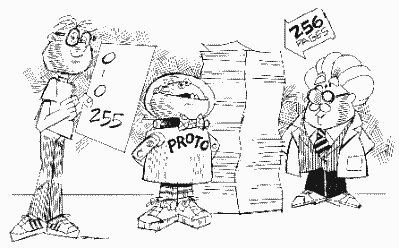WHAT IS A MEMORY
LOCATION?
Good question! Your Atari has many "places" within it that can contain numbers. These places we call memory cells, locations, or addresses. You may use any of these words to mean the same thing, but "address" is the more formal term that you will hear computer programmers using. Since the computer can remember the numbers in each of these places, it is common to call them the computer's MEMORY. Memory is like many blank pages of paper. Each page can hold only 256 numbers, and we can have up to 256 of these pages.

So where does this leave us? Well, 256 locations per page times 256 pages gives us 65536 locations total that CAN be in your computer. Computers count in terms of something called a "K." For reasons beyond my control, one K of memory is actually 1024 locations. Why? I'll explain all in a few pages. For now divide 65536 by 1024 to get a possible memory size for the Atari of 64K. Oops! When you bought your Atari, the salesperson probably told you it had only 16K or 48K. Let's solve this very great mystery.
The Atari is capable of using 64K of memory. The factory gives you 16K ROM and 16K or 48K RAM when you buy the computer (we'll explain ROM and RAM later), but there is a catch (of course). A lot of the memory that comes with the Atari is already filled up with numbers that tell the computer how to run. The blank area available for you to use is a lot less than you're led to expect. If you want more memory, you have to go down to your friendly dealer and buy it. Memory additions come in 16K, 32K, and 48K plug-in "cartridges." My grandmother once told me, "Do yourself a favor, buy the large economy size, you'll need it." She was talking about soap, but her wisdom applies to computers as well.
Now that you understand how much memory you have, let's talk about it a little. Each memory address can hold numbers from 0 to 255. Computers start counting at 0 because "nothing" is a very valid piece of information. I certainly worry when my wallet has "0" in it! Let's learn how computers count.
Return to Table of Contents | Previous Chapter | Next Chapter

